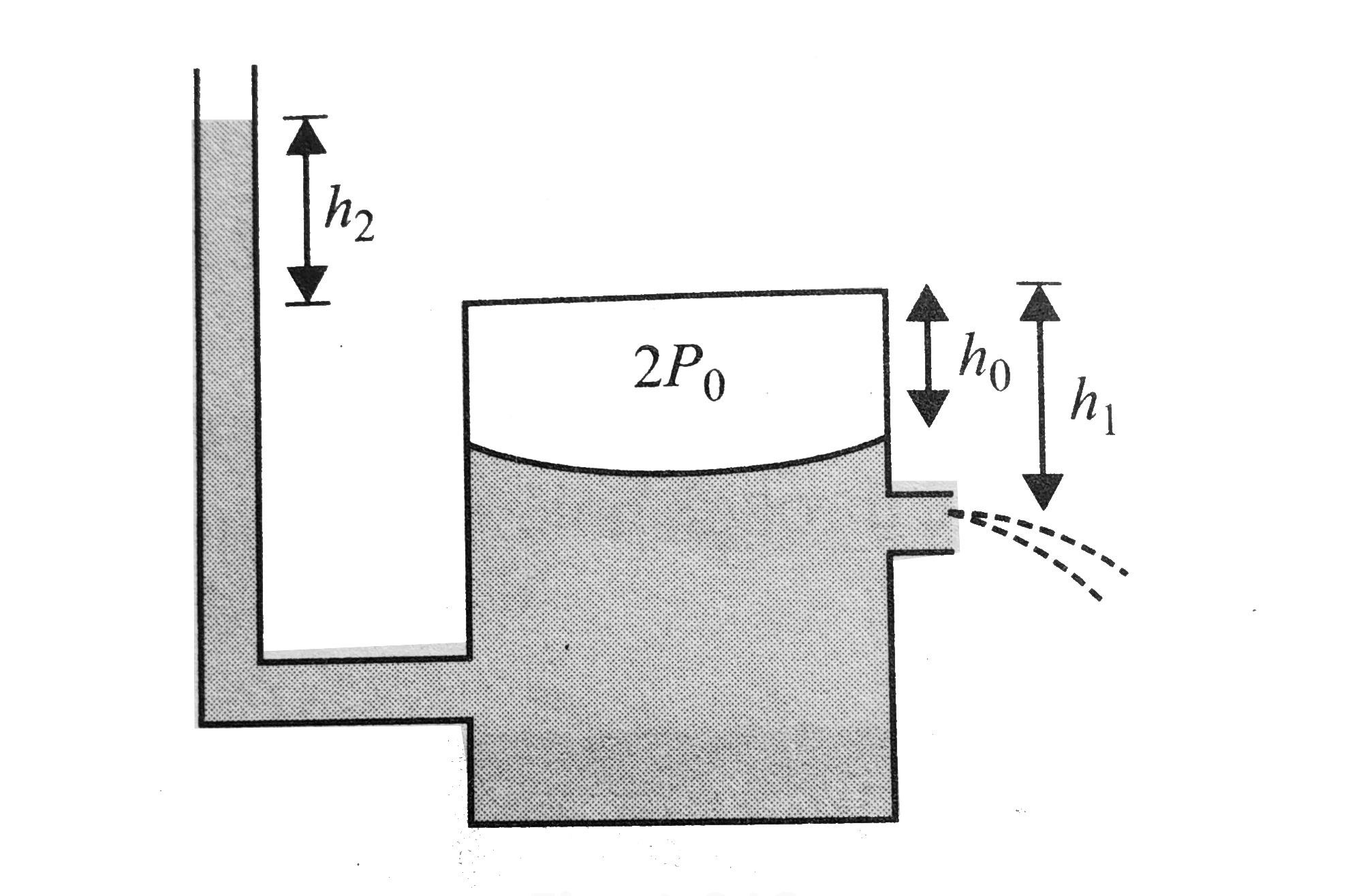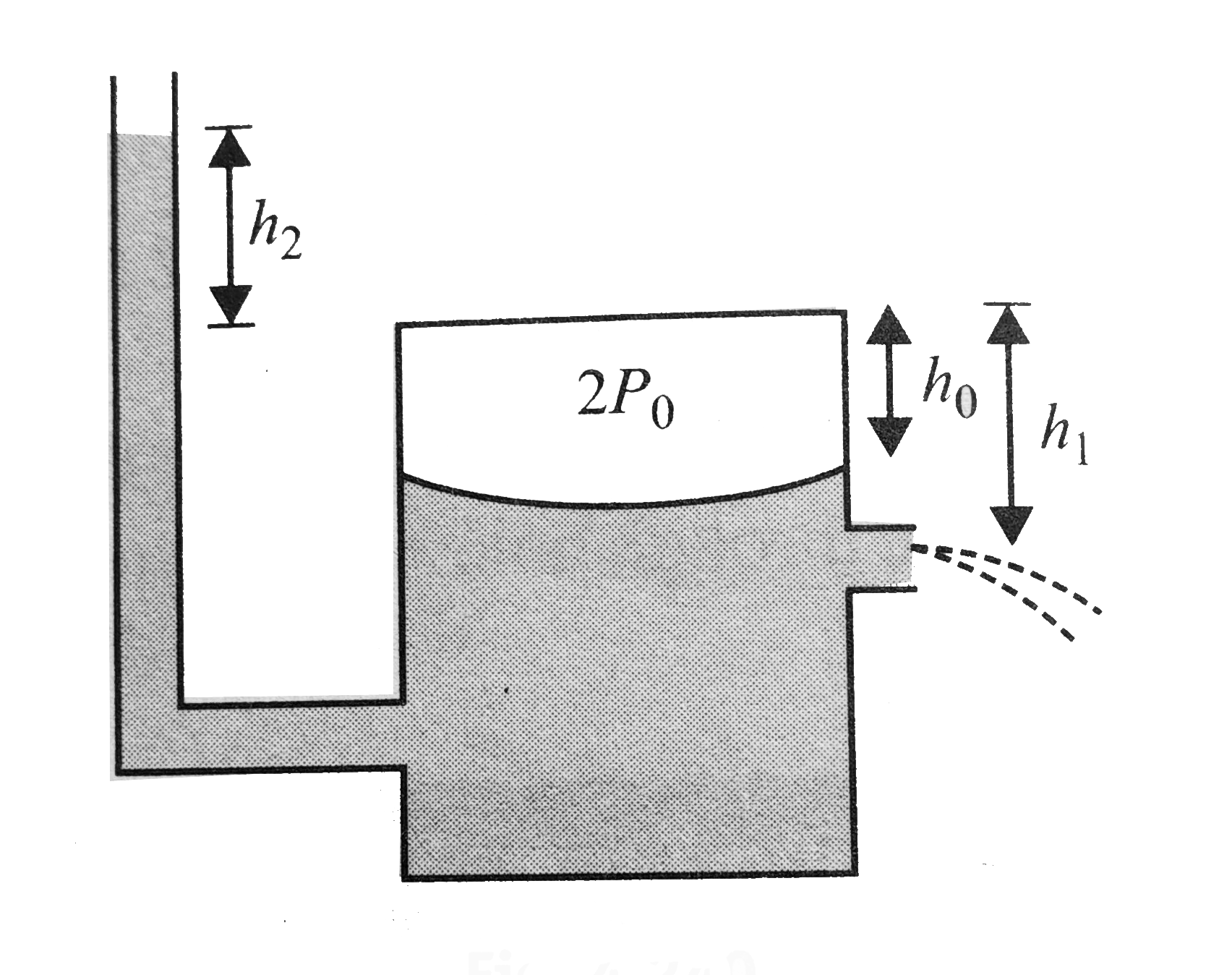Figure shows a large closed cylindrical tank containing water. Initially, the air trapped above the water surface has a height h0 and pressure 2p0 where rh0 is the atmospheric pressure. There is a hole in the wall of the tank at a depth h1 below the top from which water comes out. A long vertical tube is connected as shown.

Find the height h2 of the water in the long tube above top initially.
3p0ρg−h03
2p0ρg−h02
p0ρg−h0
p02ρg−2h0
The correct Answer is:C
2P0=(h2+h0)ρg+p0
(since liquids at the same level have the same pressure)
P0=h2ρg+h0ρg
h2ρg=P0−h0ρg
h2=P0ρg−h0ρgρg=P0ρg−h0
KE of the water = Pressure energy of the water at that layer
12mV2=m×Pρ
V2=2Pρ=2ρ[P0+ρg(h1−h2)]
V=[2ρ{P0+ρg(h1−h0)}]12
We know 2P0+ρg(h1−h0)=P0=ρgX
⇒X=P0ρg+(h1−h0)=h2+h1
i.e., X is h1 metre below the top or X is −h1 above the top.
Topper's Solved these Questions
- FLUID MECHANICSBook:CENGAGE PHYSICSChapter:FLUID MECHANICSExercise:True/False
Explore 1 Video
- FLUID MECHANICSBook:CENGAGE PHYSICSChapter:FLUID MECHANICSExercise:SCQ_TYPE
Explore 13 Videos
- FLUID MECHANICSBook:CENGAGE PHYSICSChapter:FLUID MECHANICSExercise:Assertion-Reasoning
Explore 8 Videos
- DIMENSIONS & MEASUREMENTBook:CENGAGE PHYSICSChapter:DIMENSIONS & MEASUREMENTExercise:Integer
Explore 2 Videos
- GRAVITATIONBook:CENGAGE PHYSICSChapter:GRAVITATIONExercise:INTEGER_TYPE
Explore 1 Video
Similar Questions
Shows a large closed cylindrical tank containing water, Initially the air trapped above the water surface has a height h0and pressure2p0where p0is the atmospheric pressure. There is a hole in the wall of tank at a depth h1below the top from which water comes out. A long vertical tube is connected as shown. (a) Find the height h2 of the water in the long tube above the top initially. (b) Find the speed with which water comes out of hole.(c)Find the height of the water in the long tube above the top when the water stops coming out of the hole.

View SolutionAtmospheric pressure is P0 and density of water at the sea level is ρ0. If the bulk modulus of water is B, calculate the pressure deep inside the sea at a depth h below the surface.
View Solution
Knowledge Check
Figure shows a large closed cylindrical tank containing water. Initially, the air trapped above the water surface has a height h0 and pressure 2p0 where rh0 is the atmospheric pressure. There is a hole in the wall of the tank at a depth h1 below the top from which water comes out. A long vertical tube is connected as shown.

Find the height of the water in the long tube above the top when the water stops coming out of the hole.A−2h0Bh0Ch2D−h1Figure shows a large closed cylindrical tank containing water. Initially, the air trapped above the water surface has a height h0 and pressure 2p0 where rh0 is the atmospheric pressure. There is a hole in the wall of the tank at a depth h1 below the top from which water comes out. A long vertical tube is connected as shown.

Find the speed with which water comes out of the holeA1ρ[p0−ρg(h1−2h0)]12B[2ρ[p0+ρg(h1−h0)]]12C[3ρ[p0+ρg(h1+h0)]]12D[4ρ[p0−ρg(h1−h2)]]12The height of the water in a tank is H. The range of the liquid emerging out from a hole in the wall of the tank at a depth 3H4 from the upper surface of water, will be
AHBH2C3H2D√3H2
An air bubble is formed at depth h below the surface of water. The pressure inside the bubble is-
(P0= atmospheric pressure, r = radius of bubble)
View SolutionThe pressure at the bottom of an open tank of water is 3p where p is the atmospheric pressure. If the water is drawn out till the level of water remains one fifth, the pressure at the bottom of the tank will now be
View SolutionA water tank, open to the atmosphere, has a leak in it in the form of a circular hole, located at a height h below the open surface of water. The velocity of the water coming out of the hole is :
View SolutionA water tank, open to the atmosphere, has a leak in it in the form of a circular hole, located at a height h below the open surface of water. The velocity of the water coming out of the hole is :
View SolutionA tank with vertical walls is mounted so that its base is at a height H above the horizontal ground. The tak is filled with water to a depth h. A hole is puched in the side wall of the tank at a depth x below the water surface. To have maximum range of the emerging stream, the value of x is
View Solution

